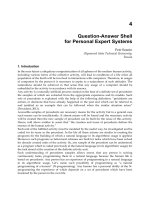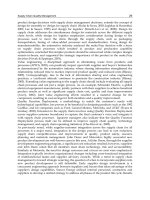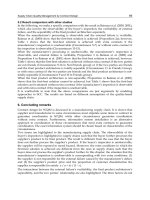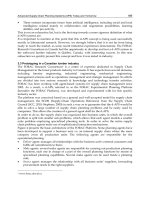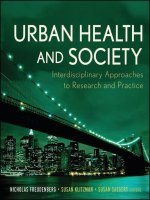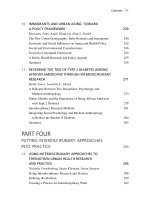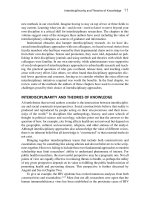Urban Health and Society: Interdisciplinary Approaches to Research and Practice - Part 3 docx
Bạn đang xem bản rút gọn của tài liệu. Xem và tải ngay bản đầy đủ của tài liệu tại đây (101.76 KB, 10 trang )
PART
1
INTRODUCTION
c01.indd 1c01.indd 1 6/5/09 2:09:30 PM6/5/09 2:09:30 PM
c01.indd 2c01.indd 2 6/5/09 2:09:31 PM6/5/09 2:09:31 PM
CHAPTER
1
FRAMEWORKS FOR
INTERDISCIPLINARY
URBAN HEALTH
RESEARCH AND
PRACTICE
NICHOLAS FREUDENBERG, SUSAN KLITZMAN, SUSAN SAEGERT
LEARNING OBJECTIVES
■ Offer three reasons why interdisciplinary research approaches are especially suit-
able for investigation of urban health problems.
■ Explain the characteristics of cities that affect the public health challenges they face
and that make urban health problems particularly appropriate for interdisciplinary
study.
■ Compare and contrast unidisciplinary and interdisciplinary research from the point
of view of both substance and the processes involved, as well as the challenges
inherent in interdisciplinary research.
c01.indd 3c01.indd 3 6/5/09 2:09:31 PM6/5/09 2:09:31 PM
4 Frameworks for Interdisciplinary Urban Health Research and Practice
■ Describe approaches to overcoming interdisciplinary challenges related to assump-
tions, methods, institutional settings, and the focus of interventions.
INTRODUCTION
For the past two centuries, cities and urbanization have been a dominant infl uence on
health and disease, and today, more of the world ’ s population lives in cities than ever
before. In 2007, half of the world ’ s population lived in urban areas, and by 2030,
three - quarters will live in cities.
1
,
2
For health researchers and practitioners, under-
standing how the urban environment infl uences health and well - being will determine
how successful we are in caring for individuals and families, in promoting population
health, and in achieving local, national, and global health goals.
More broadly, as the United Nations State of the World’s Cities report noted in
2001, “ For better or worse, the development of contemporary societies will depend
largely on understanding and managing the growth of cities. The city will increasingly
become the test bed for the adequacy of political institutions, for the performance of
government agencies, and for the effectiveness of programmes to combat social exclu-
sion, to protect and repair the environment and to promote human development. ”
3
As the urban population grows and as cities become more diverse and complex, it
becomes increasingly diffi cult for any single individual, academic discipline, profes-
sion, institution, or agency to develop the insights and skills needed to improve the
health of urban populations or to create healthier cities. Despite the growing recognition
that only interdisciplinary research and practice can solve the health challenges facing
cities today, most universities still train health researchers and professionals in a single
discipline, teach them only a few research methods, and do not acquaint their students
with the growing literature on interdisciplinary approaches to health. In this volume, we
seek to remedy this problem by introducing students, researchers, and practitioners in
public health, medicine, social work, nursing, sociology, anthropology, psychology,
urban planning, geography, and other disciplines to the concepts of interdisciplinary
approaches to urban health research and practice. Our goals are to familiarize readers
with the emerging concepts and principles that characterize interdisciplinary urban
health research, to provide case studies of interdisciplinary health research within cities,
and to prepare readers to work more effectively within interdisciplinary research and
intervention teams.
This volume grows out of our own experiences as researchers and teachers, from
our reading of several bodies of literature, and from recent calls for more emphasis on
interdisciplinary education and research. Since the early 1980s, we have separately
and together studied, developed, directed, and evaluated interventions to address sev-
eral quintessential urban social, health, and environmental problems: childhood lead
poisoning, asthma, deteriorated housing, HIV infection, reentry from jail, violence
and crime, mothers ’ and children ’ s mental health problems, and obesity and diabetes.
In each of these cases, our efforts to understand and reduce the health problems facing
c01.indd 4c01.indd 4 6/5/09 2:09:31 PM6/5/09 2:09:31 PM
Introduction 5
urban neighborhoods forced us to transcend the disciplinary boundaries of our profes-
sional training and to learn new languages, concepts, and methods.
As teachers at City University of New York (CUNY), the largest urban public
university in the nation, and Vanderbilt University, we also bumped against disciplin-
ary boundaries. Our graduate students in psychology, public health, environmental
health, health education, nursing, public policy, and sociology — many of them work-
ing in the health fi eld during the day — wanted to take courses, learn skills, and integrate
methods from different disciplines to succeed in solving the problems they faced in
their own research and in jobs at the municipal health department, in voluntary health
agencies, or with community organizations. Too often, however, the requirements of
accrediting agencies, the curriculum or departmental structure of our universities, or our
own limitations as disciplinary researchers made it diffi cult for our students to achieve
their interdisciplinary objectives. Recently, we have worked to develop at CUNY a vari-
ety of interdisciplinary approaches to graduate education for social science and public
health students interested in urban health. These experiences have reinforced our view
of both the potential and the obstacles facing interdisciplinary study.
As social scientists and health researchers, we are infl uenced by several emerging
bodies of literature on urban health, on social determinants of health, on social support
and health, on health inequities and disparities, on various participatory research meth-
ods, and on human rights, social justice, and health. Each of these fi elds has been
developed by investigators from several disciplines, and each has begun to establish an
interdisciplinary foundation that can guide future research and intervention. Although
these new developments have informed our research and teaching, we have also been
frustrated with the diffi culty of developing for ourselves and our students a user - friendly
synthesis of these emerging principles, theories, and methods that can guide research
and practice. Once again, our own and our colleagues ’ disciplinary roots make it diffi -
cult to integrate new scholarship across levels and disciplines.
Finally, this book is a response to several recent calls for more attention to inter-
disciplinary research and education. In its report The Future of the Public ’ s Health in the
21st Century,
4
the National Academies Press emphasized the importance of interdisci-
plinary education in health. It called on universities to “ increase integra ted interdisciplinary
learning opportunities for students in public health and other related health science pro-
fessions . . . and interdisciplinary education and appropriate incentives for faculty to
undertake such activities. ” The 2003 National Academies Press report Who Will Keep
the Public Healthy?
5
also stressed the need for more interdisciplinary education for
biomedical and social science researchers. In its 2005 report Facilitating Interdis-
ciplinary Research ,
6
the National Academies Press suggested that graduate students
should explore ways to broaden their experience by gaining “ requisite ” know ledge in
one or more fi elds in addition to their primary fi eld. They also suggested that research-
ers and faculty members desiring to work on interdisciplinary research, education, and
training projects should immerse themselves in the languages, cultures, and knowledge
of their collaborators.
c01.indd 5c01.indd 5 6/5/09 2:09:31 PM6/5/09 2:09:31 PM
6 Frameworks for Interdisciplinary Urban Health Research and Practice
In its effort to chart a “ road map ” for medical research in the twenty - fi rst century,
the National Institutes of Health observed that “ the scale and complexity of today ’ s
biomedical research problems increasingly demand that scientists move beyond the
confi nes of their own discipline and explore new organizational models for team
science. ”
7
As urban health researchers and teachers, we support these calls for new
paradigms but note the lack of practical tools for achieving these ambitious aims. We
hope this volume will help to fi ll this gap.
Finally, the Institute of Medicine, the Council on Education for Public Health, and
other bodies have called on schools of public health to strengthen preparation of students
in interdisciplinary collaboration and communication. Most faculty and resear chers
agree in principle with this call, but few have developed practical strategies for meeting
this new mandate or found ways to equip students with the competencies to defuse the
land mines one encounters when crossing disciplinary boundaries. This book hopes to
meet that need.
In sum, we hope this collection of essays will help to educate health professionals
and researchers who can transcend the limitations we have faced. By introducing stu-
dents early in their careers to the concepts and methods of other disciplines, by describing
the benefi ts but also the real - world challenges that interdisciplinary researchers face,
and by presenting case studies from the interdisciplinary front lines of public health and
social science research and practice, we hope today ’ s students will be better prepared to
accept interdisciplinary approaches as the norm rather than the exception. In this chapter,
we introduce several themes that are developed in subsequent chapters.
THE IMPLICATIONS OF URBAN LIFE FOR HEALTH
One recurring theme is that interdisciplinary research and the fi eld of urban health are
good partners for a lasting relationship. What makes the health of urban populations
especially suitable for these interdisciplinary approaches?
First, like coral reefs or tropical rain forests, cities are complex biological, social,
and physical systems in which organisms (in this case, humans are our main interest)
interact with each other and their environment at the molecular, local, and global levels.
No single discipline can capture the complexity of these interactions, and only inter-
disciplinary methods can consider these dynamics at several levels simultaneously.
8 ,
9
Second, cities have diverse populations. Population heterogeneity sets the stage for
a variety of biological, cultural, political, and social encounters among and within the
various subpopulations. For example, understanding the health implications of the food
practices of urban ethnic groups and their varying interactions with the urban food sys-
tem requires nutritional, anthropological, sociological, and psychological expertise,
10
as Zenk and her colleagues describe in Chapter Three .
Third, cities have dense populations. Sociologists, economists, and biologists have
studied the consequences of population density for more than 200 years, and more
recently, epidemiologists and psychologists have also taken on this issue. Some research
suggests that density contributes to negative effects on physical and mental health, but
c01.indd 6c01.indd 6 6/5/09 2:09:32 PM6/5/09 2:09:32 PM
The Implications of Urban Life for Health 7
other studies document increased access to health services, close knit subcultures, and
greater freedom of choice and personal development. By integrating the fi ndings on
density from these various disciplines, it may be possible to develop a more nuanced
view of the various ways that density infl uences health. More pragmatically, under-
standing the complex ways that density affects health can assist urban planners to
design cities and neighborhoods that better promote well - being. In Chapter Nine ,
Hadley and colleagues examine how urban density shapes the health consequences of
disasters such as earthquakes, tsunamis, or terrorist attacks.
Fourth, because most cities are characterized by high levels of inequality, inter-
ventions — even benefi cial ones — run the risk of reinforcing or even widening disparities
in health.
11
Thus, opening new municipal fi tness centers may exacerbate the gap in
physical activity levels between the poor and the better off unless the poor have what
Paul Farmer has called a “ preferential option ” for the new services.
12
What is benefi -
cial at the individual level may be harmful to population health and to social justice. To
avoid this unintended effect, urban public health planners need to defi ne disparity
reduction as an explicit goal. This requires thinking across levels and considering tech-
nical and ethical concerns; both tasks are suited to interdisciplinary research. In Chapter
Six , Geronimus and Thompson examine the multiple pathways by which public policies
have often undermined the health of African American communities.
Fifth, most cities organize the municipal services that affect health in sectoral pro-
grams: education, health care, sanitation, water, or housing. Each sector has its own
experts, and rarely do policymakers or researchers consider the impact of develop-
ments in one sector (e.g., increasing rates of high school dropout) on outcomes in
another (e.g., longevity or premature death). For urban residents, however, it is the
totality of their environment and the services available to them that shape their living
conditions. Interdisciplinary research can begin to examine these intersections across
levels and sectors and analyze their impact on health. Saegert and her colleagues pro-
vide such an example in Chapter Seven in their analysis of the health consequences of
housing foreclosures.
Sixth, compared to other areas, cities have a rich array of social and human
resources — dense social networks, many community - based organizations, and diverse
formal and informal service providers. These human resources and the social capital
inherent within them constitute key assets for urban health promotion, and effective
public health programs use these resources both to root interventions in a specifi c
urban context and to reduce the need for external resources.
13
– 15
Recent work on social
capital in psychology, sociology, and public health demonstrates the potential for both
theory and research in this area and the value of investigating the dynamic interac-
tions among different social levels.
16
–
18
For example, in Chapter Ten , Fahs and her
colleagues assess the contributions that immigrant urban communities can bring to
healthy aging, and in Chapter Eleven , Jones and Liburd describe some of the assets
that African American communities can bring to the task of reversing the diabetes epi-
demic. Finding the right assets, mobilizing them, and ensuring their sustainability are
important tasks for urban health interventionists.
c01.indd 7c01.indd 7 6/5/09 2:09:32 PM6/5/09 2:09:32 PM
8 Frameworks for Interdisciplinary Urban Health Research and Practice
Seventh, the development of modern cities and their impact on the health and well -
being of their inhabitants are dynamic across time and place. For example, although
many cities in North America and Europe began experiencing unprecedented popula-
tion expansion during the latter half of the nineteenth century, it was not until a century
later that many of their southern counterparts in Asia, Africa, and Latin America did so.
Temporal and geographic differences are also manifest in disease patterns: Many northern
cities have experienced signifi cant overall declines in infectious diseases and subsequent
increases in longevity, although these diseases continue to burden disproportionately dis-
advantaged subgroups in the population. Now, developed world cities are battling
noninfectious diseases like cancer, diabetes, heart disease, and Alzheimer ’ s disease that
are associated with cumulative exposures, aging, and long latency periods. Meanwhile, in
many developing world cities, infectious diseases like HIV/AIDS, tuberculosis, malaria,
and dengue fever are still raging, shortening life spans, and imposing misery. To under-
stand the growth and character of cities and their impact on health requires that we
consider a myriad of historical, geographic, economic, political, and social forces. No sin-
gle discipline possesses the framework and tools for such an analysis.
In sum, we seek to show that the methods of interdisciplinary research can help to
understand better the outcome of the health of urban populations. The complex health
conditions facing cities have determinants and consequences at multiple levels of bio-
logical and social organization, and they vary signifi cantly across time and place. In
addition, they often need to effectively address simultaneous changes in behavioral,
community, organizational, and policy domains. No single discipline can provide the
tools needed to operate in these many dimensions.
LEVELS AND TYPES OF INTERDISCIPLINARITY
Our second theme is that interdisciplinarity is best considered a continuum rather than
a polarity with disciplinary approaches. In our view, any specifi c research project,
intervention, or program in urban health can be located along a continuum that begins
with disciplinary approaches, proceeds to multidisciplinary, then to interdisciplinary,
and fi nally to transdisciplinary. Examples of disciplinary approaches to the study of
urban health abound in the peer - reviewed and popular literature — sociological studies
of urban crime, psychological studies of population density and crowding, environ-
mental health studies of urban noise, air pollution, or childhood lead poisoning, and
clinical studies of anti - hypertension, cholesterol, or malarial drugs.
Multidisciplinary research joins investigators from different fi elds to bring their
own methods and concepts to a common problem. As Stokols and others have noted,
19
fi elds such as public health and urban planning are inherently multidisciplinary in that
they encompass several different disciplines whose perspectives are combined in anal-
yses of complex topics, such as population health and urban development. For example,
epidemiologists, environmental health researchers, pediatricians, housing specialists,
and psychologists have studied the epidemic of childhood asthma in U.S. cities. Each
researcher uses his or her analytic methods and concepts to examine the role of, say,
c01.indd 8c01.indd 8 6/5/09 2:09:32 PM6/5/09 2:09:32 PM
Levels and Types of Interdisciplinarity 9
air pollution, quality of medical care, housing characteristics, diet, or parental manage-
ment in the prevalence of asthma or the severity of symptoms. And as Fuqua and her
colleagues show in Chapter Eight , reducing the toll from tobacco has forced research-
ers from many disciplines to form innovative research collaboratives. Occasionally,
these investigators work together, and such efforts have led to a better understanding of
asthma. Too often, however, multidisciplinary research resembles more the parallel
play of toddlers than the collaborative work of a single team. Differences in language,
methods, scale, and outcome make it diffi cult to integrate fi ndings across disciplines
and to develop science - based multilevel interventions to improve urban health.
The National Academies Press has defi ned interdisciplinary research as “ a mode of
research by teams or individuals that integrates information, data, techniques, tools, per-
spectives, concepts, and/or theories from two or more disciplines or bodies of specialized
knowledge to advance fundamental understanding or to solve problems whose solutions
are beyond the scope of a single discipline or fi eld of research practice. ”
6
The operative
distinction with multidisciplinary approaches is the integration of perspectives from two
or more disciplines. Several chapters illustrate this process, including Angotti and Sze in
Chapter Two , who integrate urban planning with historical and environmental health
approaches to the study of urban environmental hazards and Maantay and her colleagues,
who in Chapter Five synthesize geographic and medical perspectives to better understand
childhood asthma.
More recently, Stokols and others have proposed the term “ transdisciplinary
research, ” which is characterized by a deliberate integration of concepts and methods
from several fi elds to address a common problem. It results in “ collaborative products ”
that “ refl ect an integration of conceptual and/or methodological perspectives drawn
from two or more fi elds. ”
19
Their work on tobacco control,
19
recent studies of the obe-
sity epidemic,
20
–
22
and studies of child development in urban settings, described by
Ferguson and colleagues in Chapter Four , illustrate transdisciplinary approaches. In
some cases, transdisciplinary approaches lead to the creation of new discipline that
integrates previously separate ones. For example, the new fi eld of “ cognitive science ”
brings together researchers and methods and concepts from anthropology, artifi cial
intelligence, neuro science, education, linguistics, psychology, and philosophy.
6
I n
Chapter Twelve , we consider the advantages and disadvantages of viewing urban
health as a new transdisciplinary fi eld.
To help readers locate their own efforts and the cases described in this volume on
the disciplinarity continuum, it may be helpful to describe some of the characteristics
that distinguished more unidisciplinary research from interdisciplinary research (IR).
First, the starting point for IR is often a problem rather than a single hypothesis about
the relationship between two variables. Second, IR often struggles to defi ne a common
language and concepts, a task not usually needed in disciplinary research. Third, IR
often works at two or more levels of organization, requiring more sophisticated
methods to account for the infl uences of one level on another. Fourth, IR is less often
guided by theory, in part because theories often describe only one analytic level or are
bounded by a single discipline. Finally, compared to the frequently incremental approach
c01.indd 9c01.indd 9 6/5/09 2:09:32 PM6/5/09 2:09:32 PM
10 Frameworks for Interdisciplinary Urban Health Research and Practice
of disciplinary research, in which each research fi nding contributes a small addition to
a fuller picture of the question of interest, IR may take a more dynamic approach.
Integrating fi ndings across levels may lead to a reformulation of basic concepts and
a reframing of research questions.
In our view, the important task is not so much how to create precise defi nitions that
distinguish among the points on the disciplinarity continuum but rather to help research-
ers decide where to locate their own efforts. Our own experience and the chapters in
this volume suggest that this decision is based on the nature of the problem under study
and the specifi c research questions that drive this decision and not on inherent charac-
teristics of the different degrees of disciplinarity. Although we appreciate the distinction
between interdisciplinary and transdisciplinary research, in this volume, we generally
use the more common term interdisciplinary for clarity and simplicity.
CONUNDRUMS IN INTERDISCIPLINARITY
A third theme that emerges from this book is that interdisciplinary research is diffi cult.
We resist the effort to paint it as the ideal solution to all complex problems and argue
instead that researchers need to have a clear rationale for its use in any specifi c situation.
What makes interdisciplinary research so challenging? First, the value of disciplines —
part of the reason they emerged — is to help focus attention on a defi ned set of variables,
usually at a single analytic level and informed by a small number of relevant theories.
Once researchers give up the disciplinary lens, they can be dizzied by choices — like
looking through a microscope, binoculars, and a telescope simultaneously. And interdis-
ciplinary approaches offer not only multiple ways of framing the problem but also multiple
methods of collecting and analyzing data. Choosing this path signifi cantly expands the
number of choices a researcher needs to make.
A related challenge is integrating methods and theories from different analytic
levels or different levels of social organization. In some cases, methodologies such as
multilevel statistical models or structural equation modeling provide a framework for
explaining the relationship among different levels, but the simplifi ed assumptions
these models require may limit the insights they can offer. In childhood lead poison-
ing, for example, the child ’ s nutritional status, behavioral patterns, interactions with
parents, and access to health care, as well as the living conditions inside the house-
hold, the building, the block, the neighborhood, and the policies of the city, state, and
national government all infl uence the individual and population prevalence of elevated
lead levels. How do we integrate fi ndings from these different levels to develop more
effective lead poisoning prevention policies and interventions? The practical diffi culty
explains why researchers often choose to focus on a single level using data and theo-
ries from a single discipline — even if such studies are of limited use in the development
of effective prevention policies.
Another diffi culty for the researcher considering interdisciplinary approaches is
the sheer volume of knowledge needed to be effective in this task. The unread journals
that pile up in our own offi ces show how hard it is to keep up with new fi ndings and
c01.indd 10c01.indd 10 6/5/09 2:09:32 PM6/5/09 2:09:32 PM
